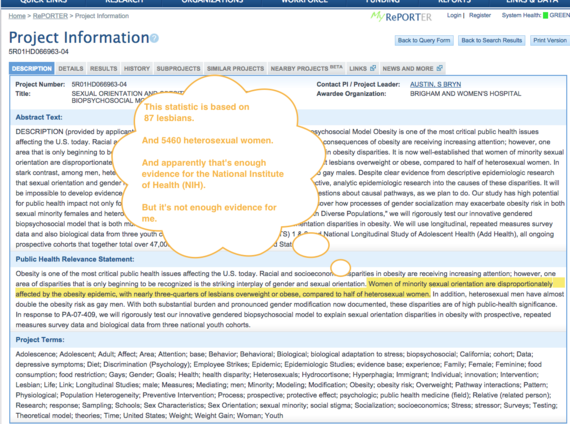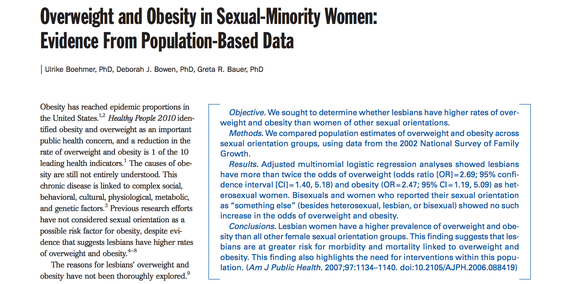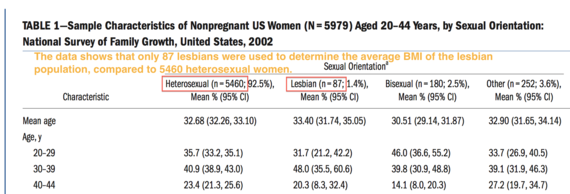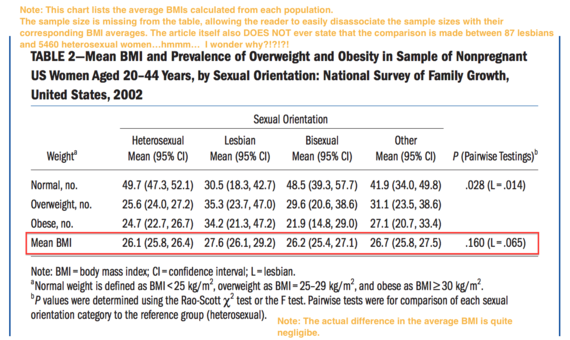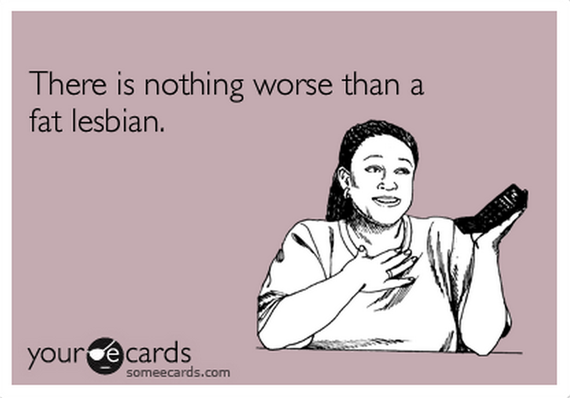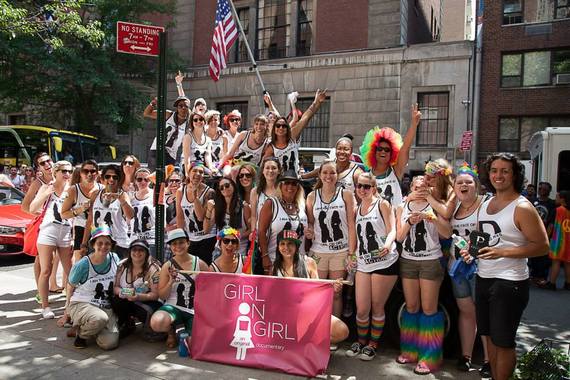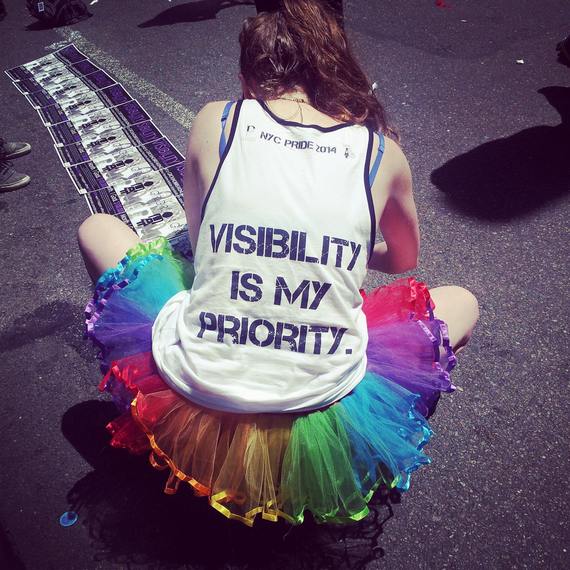The Problem With the '75 Percent of Lesbians Are Fat' Statistic
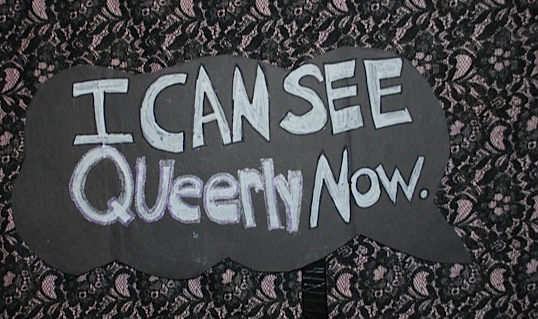
It is 8:15 a.m. on a Saturday morning, and I just spent no less than six hours completely consumed by statistical farce. My head is pounding, my eyes are burning, the air-conditioning seems unconscionably loud, and all I want to do is eat some cereal and go to bed. But alas, I am writing. I know if I stop now, I’ll never be able to maneuver my way back through this vortex of numbers, articles, side notes and screenshots to logically prove to you how painfully misleading and downright stigmatizing this “75 percent of lesbians are overweight or obese” media frenzy is.
My bookmark folder on “lesbian obesity and stigmatization” was born in March 2013, when the study purporting to examine the “interplay of gender and sexual orientation in obesity disparities,” funded by The National Institutes of Health’s (NIH) Eunice Kennedy Shriver National Institute of Child Health and Human Development (NICHD), only had a million and a half dollars to its name.
Buried in the abstract of the study appears the line, “three-quarters of lesbians are obese,” a statistic employed by the lead researcher as evidence to support funding, and subsequently exploited by the news media to critique ludicrous government spending. Several articles surfaced highlighting the latter, first trickling in on my keyword “lesbian” Google News alert, and then flitting about my newsfeed outfitted with the same semantic bait: “The Government Spends Millions on ‘Lesbians Are Fat’ Study.” One second-rate article after another framed the NIH grant as a “disturbing waste of tax dollars,” that ignored the “well-being of the nation as a whole,” because let’s face it, who really cares about lesbians? Especially fat lesbians. It was insufferable.
The first time around, the lesbian blogosphere did not seem to pay the story much heed. I was inundated with work, so rather than rise to the occasion, I decided to do some research, and file my rebuttal into the “stories to write later” folder. Then last week, like déjà vu, the headline resurfaced with a vengeance. They say, “pick your battles,” and this time, I was ready with plenty ammo. I watched my newsfeed and waited. I wanted to see if anybody else would pick up on what I had found…
Here was Autostraddle saying that the statistic “missed the point” entirely, and extolling queer culture for being more open to loving ladies of “all shapes and sizes.” At XOJane, the author cleverly quipped about quinoa to make the jarring insult seem a little less derisive; “Sure, 75% of lesbians may be overweight or obese, but in my anecdotal experience at least 90% are also vegans, so how are those broads getting so fat on quinoa and nutritional yeast?”
I recognize these writers for their effort to rationalize a highly irrational and condemnatory statistic, and applaud their desire to further extend the message that lesbian culture is more body positive than most other subcultural communities. I do agree with that claim.
But in every post, the same questions remained unasked:
- WHAT IF 75 PERCENT OF LESBIANS ARE NOT OVERWEIGHT OR OBESE?
- What if the researchers are wrong?
- What if the widely quoted statistic that “three-quarters of lesbians are overweight or obese” is based on unsubstantiated data and extremely small sample sizes?
- What if the claim is a statistically insignificant pile of garbage that is wholly misleading?
For some odd reason, nobody ever questioned the validity of the statistic itself, when it was established as fact, or what the motivation behind the original research was in the first place. I, on the other hand, was determined to find the proof in the pudding!
My journey through the depths of Google Scholar finally led me to the same article again and again that claimed, “lesbians are more than twice as likely to be overweight or obese than heterosexual women.” This one article is cited in nearly every other major academic article on the subject of sexual minorities and BMI (body-mass index).
Here’s the kicker: Within the study, there is one specific chart that notes the sample size of lesbians used to calculate the average BMI, used to determine overweight and obesity of the group. I should have selfied my face in the moment because it would’ve made for a perfectly histrionic Tinder pic — seriously, nothing says, “Are you F*CKING KIDDING ME?!” like my face did when I realized how much this study ABSOLUTELY DID NOT statistically prove that 75 percent of lesbians are overweight and obese.
Here’s the simple reason why the statistic is a sham:
Q. How many straight women were in the sample size?
A. 5,460
Q. How many lesbians were in this sample size?
A. 87
The article is called “Overweight and Obesity in Sexual-Minority Women: Evidence From Population-Based Data” (Boehmer et al.). Read it for yourself. You will not find the number “87” lesbians ANYWHERE in the text. You have to actually look at the chart that doesn’t list the average BMIs to find the “n” value for the lesbian sample size (in statistics, n = the sample size). Look for yourself. I’ll give you a second…
Exhibit A): This chart shows that the sample size used to calculate the average BMI (body mass index) for lesbians is n=87, and that for heterosexual women, that value is n= 5460.
Upon seeing the number, you most likely will need a second to process the b*llsh*t for yourself: 87 is, in fact, the number of lesbians used to make a sweeping claim about lesbians being overweight and obese.
YES, I SWEAR. THE SAMPLE SIZE USED IN THIS STUDY IS 87 LESBIANS AND 5,460 STRAIGHT WOMEN. Unless I am missing something MAJOR, this article, along with a whole slew of other articles that go on to cite it, is conclusive of nothing. To base an entire population’s average BMI on 87 women is absurd. And I really don’t think I missed anything major. The “n” value here is pretty damn clear.
The crux of the issue is this: How can any study, let alone one that intends to make sweeping generalizations about the impact of sexual orientation on an entire populations’ BMI, consider 87 people a reasonable and adequate sample size? How can 87 women possibly stand to represent ALL lesbians in the USA?! I just can’t figure how in the hell is it considered academically sound, and moreover, deemed legitimate by a peer-review board of scholars, to compare 87 lesbians to 5,460 straight women??!!?!?!
I don’t care if there are fewer of us in the general population; no matter how you frame it, or weight it, or manipulate it, the average BMI of 87 lesbians “randomly” selected in 2002 means ABSOLUTELY NOTHING to us as a community. And it means nothing to me. For one to claim that this number is a statistically significant sample size large enough to draw conclusions that will have huge implications on a marginalized community’s public health perception is not just unethical, it’s insulting.
The results section of this study truly pays homage to faulty logic. The author in one sentence admits that their sample size is too small to be precise (understatement of the century!), but in the next paragraph has the audacity to claim that their population-based data are of “great relevance” and that they (the researchers) posses “rigorous evidence” to prove that lesbians are an “at-risk population for overweight and obesity.”
“It will be important for future population-based studies that include a bigger sample of lesbian women to improve on the precision of our estimates because the corresponding tests will have better power than we had. Despite these limitations, our use of these population-based data was of great relevance. We provide rigorous evidence that lesbian women are an at-risk population for over-weight and obesity, and thus, for negative health outcomes secondary to obesity.”
Just like that, based on 87 women, a statistic that “three-quarters of lesbians are overweight or obese” is born. In the years to follow, it will be successfully morphed into more egregious puns, memes and despicable jokes to mock us and delegitimize our sexuality with than I care to think about. Lesbians are fat. This claim about our community is not a joke, and to believe that the actual motivation behind this study was to benefit our community is not something I can honestly give credit to.
I am not convinced that by proving, and consequently telling, lesbians that, as a population, we’re more likely to be or become fat will promote a more positive body image or inspire government-funded public health initiatives to come into fruition. Conversely, I am certain that the publicity around this “75 percent of lesbians are fat” statistic on social media is at present exacerbating the stereotype that “lesbians are just a bunch of ugly, lazy, misguided women with low self-esteem who can’t get a husband because they’re fat and don’t wear make-up, and therefore they’re terrible people and don’t deserve to be taken seriously!” (Cue double face-palm and a simultaneous slow-head shake.)
Others will argue that this statistic has been defended in many studies other than this study of lesbian obesity. They would be correct. In fact, there are a whole slew of academic articles that employ faulty logic (many of which cite this article to make their own claim on lesbian obesity), small sample sizes, inept research questions, and arguably homophobic and fat-phobic hypotheses, in an attempt to prove that lesbians are an overweight and obese population, and that we have BMIs higher than the average heterosexual woman. But the more you research, the more you realize the myriad analyses are just more of the same inadequate data set, heavily biased by stereotypes and a general ignorance regarding lesbian identity.
The real question we should be challenging these researchers with is this: Why is homosexuality being isolated as the indicative factor of one’s failure to thrive? If the National Institute of Health (NIH) is funding studies based on this claim (and it is), it’s terrifying to imagine how often baseless statistics are disseminated as truth, and how misleading our public health policies and initiatives most likely are — especially those that single out, and arguably stigmatize, sexual-minority populations.
It is no mystery that widespread invisibility plagues the lesbian community, but finding us is not impossible. Yet, not one study has taken the steps to access a representative sample size that surveys the lesbian community to make a comprehensive assessment on lesbians’ BMI, that is, if there is a statement to be made. Maybe it’s more flabbergasting to me because I can call 1,000 lesbians to action in my sleep. Literally. I could write a status now with an embedded link to survey lesbians, go to sleep, and wake up to not only 1,000 lesbians having answered it, but the potential for a network of over 200,000 queer women to have offered up their heights and weights.
That being said, if you are a researcher with good intentions, in need of access to the queer lady demographic, I’d be more than happy to talk to you about your work. You need lesbians. I have lesbians. You have funding. I need funding. It’s a win/win. Let’s help each other out for the betterment of this community!
The bottom line: This whole thing seems disturbingly Machiavellian. At best, this study (and ones like it) is a lackluster inquiry parading as a progressive public health initiative. At worst, it is a conspiracy; a wholly disingenuous undertaking, biased by ignorance and rooted in compulsory heterosexuality and the pathological policing of gender presentation — all thanks to society’s fear of “fat”-bodied women.
Here’s why it all matters: As long as this statistic is being touted as a scientifically proven fact, we have a problem. When flung into the blogosphere, it is daily espousing a condescending correlation between lesbian identity and unhealthy weight. This notion is and will continue to affect the physical and emotional well-being of many a queer girl, both young and old. This is not okay. And you should not be okay with it.
It’s time to wake up and realize that lesbian visibility is not only about femme girls wanting to be recognized, but it is also about combating negative stereotypes and ending the institutionalized shaming of lesbian identity by bringing to light the breadth of our community. The only solution to reversing the stigmas attached to being a lesbian is to make visible the positive attributes of who we are, how we live, and what we look like. It’s not about emphasizing the average; it’s about celebrating the exceptional. It’s about coming out every day, and making our presence known, even when it seems awkward or irrelevant. It’s a commitment that 100 percent of our community must take on individually.
A final note on research privilege: Though some of the articles I’m sharing via Google Scholar are publicly downloadable, many are only accessible in full via a university’s online journal database. In order to access these articles myself, I used my library card from Nova Southeastern University, a university in South Florida that makes its “NovaCat” database available to the public if you live in Broward County. Once logged into NovaCat, I was able to search for and open articles I otherwise could not have accessed via Google Scholar or another engine, like LexisNexis. This, in and of itself, is frustrating, and speaks to the elitism inherent in academia. Limiting the public’s access to scholarly journals makes conducting and analyzing research an endeavor that is ostensibly limited to those either enrolled in or associated with a university, or lucky enough to have a university affiliated library card (or a whole lot of money to spend on each individual article!). While some public libraries have access to scholarly journals and articles, most of them limit access to patrons on-site. Therefore, for somebody who only has access to the internet at home, and limited or no access to a physical library from which to access these journals, it is impossible to review articles published by academics. This sort of research privilege is rarely discussed, and is quite disheartening and problematic.
You Might Like

